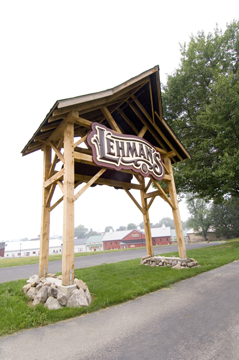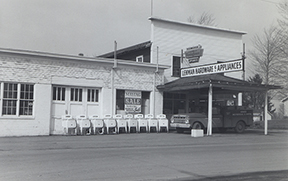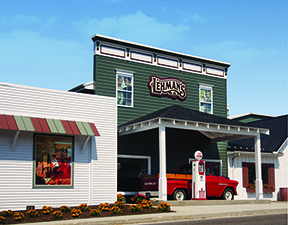Lehman's Hardware facts for kids
Lehman's is a special store in Kidron, Ohio. It started by selling things to the Amish community, who often don't use electricity. Now, it's famous worldwide for selling non-electric items. The store is huge, about 35,000-square-foot (3,300 m2), and calls itself a "Low Tech Superstore." Its motto is "For a Simpler Life," which means it helps people live without lots of modern gadgets.
The building itself is interesting! It's made from parts of an old log cabin and three buildings from before the American Civil War, including a barn built by hand. Lehman's is also a popular place for tourists to visit. You can also buy their products from their catalog or online.
Contents
Where is Lehman's Located?
Lehman's is in Kidron, Ohio. This is a small community in Wayne County, Ohio. It's in an area of Northeast Ohio where many Amish people live. There are about 56,000 Amish people in this region. This location was perfect for doing business with the Amish. Also, it's close to U.S. Route 30, which makes it easy for tourists visiting Amish Country to stop by.
The Story of Lehman's
Jay Lehman, a local businessman, started Lehman's Hardware in 1955. He wanted to sell products that didn't need electricity to the Amish community. He bought an old hardware store and gas station that had been open since 1915.
The store was doing okay, getting a little boost from tourists. But then, something big happened in 1973: the 1973 oil crisis. This was a time when oil supplies became low. People started looking for simple, low-tech tools to help them. Jay Lehman said, "The oil embargo put us on the map." This event made the store famous. Later events, like worries about computers in the year 2000, the events of September 11, 2001, and a big power outage in 2003, also brought in new customers. These events made people think about being prepared and living more simply.
Because of these changes, the types of customers at Lehman's changed a lot. In the beginning, 95% of sales were to the Amish community. By 2007, this was only about 6% to 8%.
Besides the Amish and tourists, Lehman's helps many other people. This includes people who want to live off the land, missionaries, environmentalists, and doctors in developing countries. They all buy items for simple living. The American Red Cross and Peace Corps volunteers also shop there. Even Hollywood set designers use Lehman's to find old-fashioned items for movie sets.
Jay Lehman continued to be involved with the business until shortly before he passed away in July 2020. His son, Galen, used to manage the business side. Jay's daughter, Glenda Lehman Ervin, is now the Director of Marketing. In 2021, Lehman's joined HRM Enterprises, Inc. This company also owns other businesses like Hartville Hardware and Hartville Kitchen.
How the Store Grew
Lehman's store grew quite a bit over the years. In 2007, it doubled in size to 35,000 square feet (3,300 m2). This is about a quarter of the size of a typical Target store. A big part of this new section was built inside an old barn from 1849. This barn was moved from Orrville, Ohio, and put back together at the store. They used the original hand-cut wood and wooden pegs. Lehman's even hired an Amish construction company to move and rebuild the barn. This honored the store's Amish roots and made sure the building was strong and well-built. In 2012, Lehman's updated the front of their store. They made it look like it did when it first opened in 1955.
Making and Selling Products
As Lehman's grew, it sometimes had trouble finding suppliers for certain items. This happened when companies stopped making old technology or went out of business. So, Lehman's had to find new suppliers or even start making things themselves.
For example, the Amish only buy cast iron wood-burning stoves if they are black. So, Lehman's arranges for special production runs with manufacturers. They often buy enough stoves to last for three years!
Lehman's also sells replacement parts for many of its products. They find these parts from different manufacturers. Sometimes, if a part is no longer made, they figure out how to make it themselves. They might get the raw materials and hire someone to make the parts, or even do the manufacturing in their own shop. They often do this even if they don't make a big profit, just to help their customers.
Using Modern Tech to Sell Old Tech
Lehman's has always used modern technology to promote its products and store. Because of this, sales from their website and catalog now make up 60% of the store's total income. They send out about 4,000 to 5,000 packages every week from online sales.
The store also has a popular Facebook page with over 100,000 followers. Galen Lehman's Twitter account has more than 2,600 followers. Their YouTube channel has over 100 videos. One video, where an employee explains how to use a wood stove, has been watched over 600,000 times!
Glenda Lehman Ervin said, "For many years, we were a store with a catalog. Now we're a direct sales company with a store." This shows how much their business has changed.
Working with the Amish Community
Many Amish people who shop at Lehman's are now also vendors for the store. They build 40 to 50 of the products that Lehman's sells.
Lehman's has a strong connection with the Amish because it has helped them for decades. It provides the goods they need to keep their traditional way of life. In return, Amish craftspeople create special products for Lehman's that might otherwise disappear.
The needs of the Amish community are still very important to the store. Lehman's often makes sure the Amish get what they need, even if it means saying no to people who want to buy things because of a new trend or a sudden worry.
A Fun Place for Tourists
Besides its unique products and location in Amish Country, tourists love Lehman's because it feels like a museum. Some visitors think the store sells antiques, but everything sold there is new. However, they do have real old items on display throughout the store. There's also an area called the Buggy Barn where workers show how old-fashioned tools were used. You can find a bookstore that shows films about Amish life, a cafe, and the Soda Pop Shop. The Soda Pop Shop has over 300 kinds of soft drinks and 70 kinds of root beer!
Lehman's is a very popular place to visit in Northeast Ohio's Amish Country. About 4,000 visitors come on a typical Saturday. Each year, around 500,000 people visit the store.
Non-Electric Products
Lehman's says it is the world's largest supplier of non-electric goods. They sell many different items. These include traditional things like wood heat stoves and the Reading 78 Apple Peeler. They also have modern emergency items, like radios and flashlights that you power with a hand crank.
Lehman's in Movies
In the late 1980s, Lehman's found a new way to sell its products. A person who finds props for movies contacted them. They needed an old cast iron stove for the movie Back to the Future Part III. Since that movie came out in 1990, Lehman's has provided old-fashioned props for many different movies and TV shows.
The Flood and How They Recovered
On February 28, 2011, a creek that runs under part of the Lehman's store overflowed. This caused a flash flood in the store. It was a "50-year flood," meaning it was a very rare and big flood. It happened because the weather got warm, and ice and snow blocked a pipe that usually drains water away. A storm also brought a lot of rain very quickly.
The flood sent about 18 inches (46 cm) of muddy water through the store. In some parts, the water was 3 feet (0.91 m) deep. The water moved so fast that it pushed an 18-cubic-foot refrigerator across the store! Lehman's did not have flood insurance, so they had to pay for about $100,000 in damages themselves.
The flood happened early in the morning and lasted less than three hours. Lehman's employees were told to come to work ready to clean up. When people in the community heard about the flood, many came to help. They offered their time, equipment, and food for the workers. Because of this amazing help, Lehman's was able to open some parts of the store just 30 hours later!
Over the next week, different parts of the store reopened each day. By Saturday, March 5, almost all departments were open. This was just in time for a local machinery auction, which brought many customers to Kidron. Lehman's then started a sale, offering big discounts on products that were only slightly damaged or had wet packaging.
The wood-burning stove department was the most damaged. It was the last to reopen, finally welcoming customers again on April 9, 2011.




